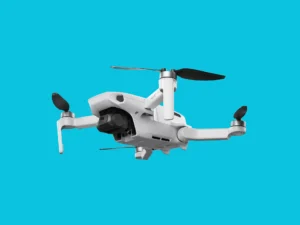Whether you want to battle Star Wars spaceships or shoot a cinematic masterpiece, one of these picks is going to be perfect for you. Top 5 Best 4K Camera Drones for Professional Vlogger – Compared & Ranked by Drone Expert
1- DJI Air 2S

DJI’s new Air 2S is our top pick. It strikes the best balance between size, weight, image quality, intelligent features, and price. Its camera isn’t quite as nice as the Mavic 2 Pro’s (see below), which has a variable aperture for more flexible shooting in sunny conditions, but adding neutral density filters to the Air 2S can help make up for the lack of aperture control.
The Air 2S is light enough (1.3 pounds) to bring on a hike yet powerful enough to fly even in light winds, and it can stay airborne for half an hour. It features an improved collision-avoidance system that should keep you out of trouble even when around trees. And the new 1-inch 20-megapixel sensor captures the beauty of the scene in stunning 5K video footage or 20-megapixel still photos.
2- Skydio 2+ Drone

The Skydio 2+ has the best collision-avoidance and navigation system of any drone in this guide. If you’re looking for a drone that can follow your mountain bike through the trees or weave around canyon walls without your frantic guidance, this is the one for you. With a 27-minute flight time and a 6-mile range, it’s not quite a match for our top pick, but it’s plenty for most people. The main reason this isn’t our top pick is the camera. The 1/2.3-inch sensor is capable of 4K footage at 60 frames per second, but it’s not quite as nice as the 1-inch sensor in the Air 2S and Evo Lite+. Video pros should also note there’s no D-log support.
Still, if you can live without D-log and aren’t bothered by the slower sensor, this drone is capable of flying through situations other drones can’t. For some use cases, that might be better than a having a larger sensor.
3- DJI Mini 3 Pro

DJI’s original Mavic Mini was a tiny, underpowered thing with a small sensor and very basic features. This third iteration (which gains the word “Pro” in the name) is anything but basic. The Mini 3 Pro uses a 1/1.3″ sensor that’s capable of 4K/60p video and 12.1 megapixel RAW Images. There’s also a 48-megapixel option, though you lose some camera features in this mode. On the front of the drone there’s a new faster F/1.7 lens. The Mini 3 Pro also packs in three-direction obstacle avoidance and a gimbal that shoots vertically, and it still manages to weigh in at less than 250 grams. That number is important, because in most jurisdictions, a drone under 250 grams doesn’t need to be registered (be sure to see to check your local laws).
The Mini 3 Pro is a joy to fly, and it can stay in the air for an amazing 45 minutes on a single charge using the extended battery—I got around 32 minutes with the standard battery. It flies very well and is surprisingly good at maneuvering in the wind. The only downside to the Mini 3 is that the price has jumped up from the Mini 2. I think the higher price is justified given the new features, but I’ve left the Mini 2 below as a budget pick since, at least for now, DJI is still selling it.
4- DJI Mini 2

The Mavic Air 2S has great collision-avoidance tech, but it’s pricey. Even the new Mini 3 Pro is $750. For a more affordable option, DJI’s Mini 2 is the way to go. It flies nearly as well as its larger siblings, though wind gusts that wouldn’t faze bigger drones like the Mavic 2 Pro will ground the Mini. The lack of collision-avoidance sensors makes it a better choice for more experienced fliers..
Despite those caveats, the Mini 2 is still a great entry-level drone. It’s fun to fly, shoots 4K video, and packs up smaller than many smartphones. That last bit is key, because the best drone is the one you actually bring with you. At a mere 249 grams, it’s easy to take the Mini 2 everywhere, and you don’t need to register it with the Federal Aviation Administration.
5- DJI Mavic 3

DJI’s Mavic 3 is in a class of its own. It’s the best drone you can buy right now. The image and video quality are amazing, thanks to the new 20-megapixel Four Thirds sensor, and the ability to travel and track objects at 45 miles per hour means you’re not going to miss a shot. The omnidirectional obstacle avoidance keeps the drone out of the trees, and it has a 45-minute flying time. It’s expensive, but in this case you get what you pay for. If that’s not enough, there’s also a Cine model ($4,999), which adds support for ProRes video and a 1-terabyte drive to store it on.
